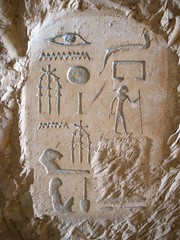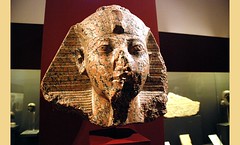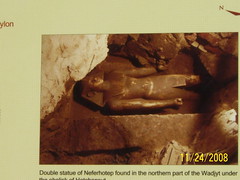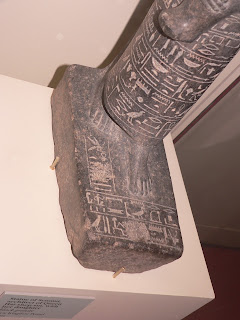I wish all of you the very best.
Regards,

A project to locate all possible Hatshepsut- related artifacts in museums and sites all over the world. Also to serve as an information sharing blog on all things Hatshepsut.

The request for help is for all. If you feel you may be able to help in some way with the above photographic project then please let me know. I am over- stretched with the Museum Database, so cannot offer my time at present. For this reason and that of obtaining all the help i can get - i thought it best to share with everyone who has been following the progress of the Hatshepsut Project.2012 - Hatshepsut Project. it would be great to have a show of hands before we hit 2012- to see who would be interested in co-ordinating or helping towards a "Hatshepsut Projet Photographic Database". I know some of you have done this in the past, but i have been so busy outside the Project to do anything significant online recently. It is, to dat,e just an idea. For a moment, forget about me and consider how much time you have to spend and whether or not you have the available resources to help produce something significant for the world to see. Although i have my own ideas, i would rather open it up to all of you. I have (more than) reached my limit on the work i can produce and extend my hands out to you all. The icing on the cake for me would be to have an Egyptologist (more if the offers are forthcoming) to oversee parts of the photographc database that would include translation/ transliteration and any insight beyone that which i myself can produce. As all work within the Hatshepsut Project (and its spin-offs) are free to all - any help will be on a voluntary basis. For that reason, i appreciate many of you will be tied up on other projects. Nevertheless, we have no other database online which we can consider "competition" and i really feel that this may be an opportunity for us all to put that right. As with all of our Projects, we will try to create something new, significant and something which everyone can use for future studies of Hatshepsut. This is the place to ask questions, so please feel free.
Thank you all for being a part of this Project. Phil Stewart, Rita Murray - let me tae this opportunity to thank you publicly for your help. I apologise for not being great with correspondance, but i am always here if you need me.
"Flinders Petrie's older study of scarab seals noted 86 seals for Thutmose I, 19 seals for Thutmose II and 149 seals for Hatshepsut while more recent studies by Jaeger estimate a total of 241 seals for Thutmose I, 463 seals for Hatshepsut and only 65 seals for Thutmose II.[12] Hence, unless there was an abnormally low number of scarabs produced under Thutmose II, this would indicate that the king's reign was rather short-lived. On this basis, Gabolde estimated Thutmose I and II's reigns to be approximately 11 and 3 full years, respectively. Consequently, the reign length of Thutmose II has been a much debated subject among Egyptologists with little consensus given the small number of surviving documents for his reign."
Ostrakon: ostracon with ink inscription
New Kingdom period
Dated 18th Dynasty, a time of Hatshepsut, ca 1502-1482 BC
Location Western Thebes, Deir el-Bahari (probably)
Dimensions H 9.5 cm, W 13.8 cm, D 3.4 cm
Materials / Techniques limestone
classification Ostrakon
The hieroglyphic text on this little OstrakonThis draught of the text on the statue of Sit- Re (Hatshepsut's Wet- Nurse) was used to complete the text on the statue itself, which was in very many pieces and incomplete.
contains a draft text of the statue of the Queen's nurse
Hatshepsut re-named Sit- Re (called In(et), which originally
Hathor temple of Hatshepsut's temple at Deir el-Bahri
was set up, and today, this statue is located in the Cairo Museum
(Cairo JE 56 264).The draft text of the statue consists of five vertical
Columns inscribed with the offering formula. In this.
Provenance
Otto Wegener Collection, Munich, collected in the 1950s
Edgar Wegener, Hamburg, 1983
Thomas Wegener, 1995
 I extend my sincerest thanks to Dr. Karl Leser for these wonderful photos. Your continued support is a major asset to my research.
I extend my sincerest thanks to Dr. Karl Leser for these wonderful photos. Your continued support is a major asset to my research.
"Chapter 8: Queen Hatasu, and Her Expedition to the Land of Punt." by Amelia Ann Blanford Edwards (1831-1892)As i stated above there are many talking points. I will higlight some of these in future posts. This document is a real gem which i am excited to have. It is made available to us by Pennsylvania University Libraries.
Publication: Pharaohs Fellahs and Explorers. by Amelia Edwards. New York: Harper & Brothers, 1891. (First edition.) pp. 261-300."

"Tonight (Kathryn) Bard will describe what has been found at the site and what these artifacts tell us about the ancient Egyptians when she delivers this year’s University Lecture, titled The Wonderful Things of Punt: Excavations at a Pharaonic Harbor on the Red Sea, at the Tsai Performance Center at 7 p.m."I am sure the above event will be worth attending. The subject matter is of high importance to Ancient Egypt and the most recent discoveries have helped to keep the name of Punt on the lips of many of us.
"I have visited Deir el-Bahri and was able to place the pencil- rubbing of the Dundee head in the gap in the south wall of the Sanctuary. It fitted exactly. The provenance of this relief is thus placed beyond all doubt. My thanks are due to Dr. L. Dabrowski and Eng. W. Kolataj of the Polish expedition working at Deir el-Bahri for their practical help on the spot".Regards,
"Of the eleven excavated foundation deposits that are connected with the Eighteenth Dynasty temple of Hatshepsut at Deir el-Bahri, one was discovered by Naville in 1894-95, two were discovered by Howard Carter and Lord Carnarvon in 1910 and 1911, and nine were discovered by the Metropolitan Museum of Art between 1922 and 1927. Largely based on the positions of these foundation deposits, Herbert Winlock postulated an original, unrealized plan for the temple that was very similar to the neighboring Eleventh Dynasty temple of Nebhepetr. A careful examination of the notes and photographs taken by the Metropolitan Museum excavation team does indicate that there are two sets of foundation deposits laying out an earlier and a later building phase. However, the first layout appears to be influenced by the existence of an early Eighteenth Dynasty structure, not by the plan of Mentuhotep’s temple"


 |
Senenmut with Princess Neferure. Diorite. Field Museum of Natural History, Chicago, 173800 by Bob Manske |
 |
Senenmut with Princess Neferure. Diorite. Field Museum of Natural History, Chicago, 173800 by Bob Manske |
 |
Senenmut with Princess Neferure. Diorite. Field Museum of Natural History, Chicago, 173800 by Bob Manske |
 |
Senenmut with Princess Neferure. Diorite. Field Museum of Natural History, Chicago, 173800 by Bob Manske |
 |
Senenmut with Princess Neferure. Diorite. Field Museum of Natural History, Chicago, 173800 by Bob Manske |
 |
Senenmut with Princess Neferure. Diorite. Field Museum of Natural History, Chicago, 173800 by Bob Manske |
 |
Senenmut with Princess Neferure. Diorite. Field Museum of Natural History, Chicago, 173800 by Bob Manske |
 |
Senenmut with Princess Neferure. Diorite. Field Museum of Natural History, Chicago, 173800 by Bob Manske |
 |
Senenmut with Princess Neferure. Diorite. Field Museum of Natural History, Chicago, 173800 by Bob Manske |
 |
Senenmut with Princess Neferure. Diorite. Field Museum of Natural History, Chicago, 173800 by Bob Manske |
 |
Senenmut with Princess Neferure. Diorite. Field Museum of Natural History, Chicago, 173800 by Bob Manske |
 |
Senenmut with Princess Neferure. Diorite. Field Museum of Natural History, Chicago, 173800 by Bob Manske |
 |
Senenmut with Princess Neferure. Diorite. Field Museum of Natural History, Chicago, 173800 by Bob Manske |
 |
Senenmut with Princess Neferure. Diorite. Field Museum of Natural History, Chicago, 173800 by Kmt-Sesh |
 |
Senenmut with Princess Neferure. Diorite. Field Museum of Natural History, Chicago, 173800 by Kmt-Sesh |
 |
Senenmut with Princess Neferure. Diorite. Field Museum of Natural History, Chicago, 173800 by Kmt-Sesh |
 |
Senenmut with Princess Neferure. Diorite. Field Museum of Natural History, Chicago, 173800 by Kmt-Sesh |